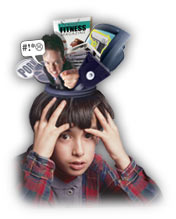It Matters a Lot What You Allow in Your Head:
The Truth About Pornography
by JoAnn Hibbert Hamilton

P ornography is rampant in our society, despite the obvious moral problems with allowing it to exist. Pornographers in the U.S. alone make $12 billion annually, and over 2.5 of that is on the Internet alone.
It’s understandable why they would fight to keep the profitable industry alive. Pornographers and those who support pornography use a couple of basic arguments to support their freedom to spread this material all over the Internet and into our communities. Fortunately, under some basic analysis, these arguments begin to fall apart.
The first major claim you’ll hear from pornographers is that is within their first amendment rights to distribute this material. While it’s true that the first amendment protects the freedom of speech, that does not mean that speech is not limited. As a civilized nation, America has laws that establish limits on things that are harmful to its people.
For example, while alcohol is legal there are limits to driving with a certain amount of alcohol in your system. Similarly, prescription drugs are limited in their distribution and use. Another example of limits established to protect people is speed limits and zoning laws.
There are laws about what is legal pornography and what is not. There are federal laws that prohibit pornographic material from crossing state lines, that prohibit child pornography and that establish a code for obscenity. There is material on the Internet that violates these laws, particularly when it comes to obscenity.
The bottom line is that it isn’t a first amendment right to hurt children by introducing them to sexuality and obscene sexual content. When looking at it in this light, all first amendment arguments fall by the wayside.
Another common argument that pornography supporters use is that pornography doesn’t hurt anyone. There is nothing that could be further from the truth. There are proven statistics that show that areas with sexually oriented businesses (such as strip clubs and adult video stores), there are higher crime rates, a decrease in property value, prostitution nearby or on the premises and public sex.
Pornography use always escalates as people search for the next thrill. The Internet exposes children, particularly boys, to a wide variety of material that can damage them for life. It takes as little as 3 months to develop a pornography addiction. In some cases, the time period is as short as 2 weeks.
A large majority of pornographic material exposes people to normal sexual stimuli at the same time that it shows violent, degrading and humiliating images. People who view pornography begin to see this violent material as a normal part of the sexual act.
The use of pornography is closely linked to molestation and other sex crimes. Over 70% of convicted molesters of boys and/or girls have admitted to using pornography. Over 50% of rapists admit to imitation pornography scenes while committing their crimes.
The evidence is clear that pornography changes a person’s thinking. Unnatural sex becomes normal and it becomes harder and harder for people to meet those abnormal sexual desires. It is clear that pornography is far from being “harmless.”
© Copyright 2009-2026 KidsEmail.org